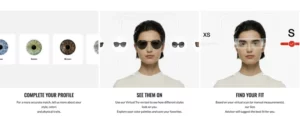Augmented reality (AR) is a technology that superimposes digital information onto the real world. There are five types of AR, including marker-based AR, markerless AR, projection AR, overlay AR, and SLAM (Simultaneous Localization And Mapping) AR. Each of these types you can use in ecommerce.
Marker-based AR
Marker-based AR, also known as image recognition AR, uses visual markers such as QR codes or specific images to trigger digital content. These markers act as reference points for AR applications to superimpose virtual elements onto the real world. Marker-based AR is accurate and reliable in marker recognition and precise alignment of virtual elements with physical markers.
Example of marker-based AR in eCommerce: Ray-Ban’s Virtual Mirror
Markerless AR
Markerless AR doesn’t require predefined markers but uses sensors, GPS, and other technologies to understand and interact with the surrounding environment. Markerless AR is more flexible, allowing digital information to be seamlessly integrated into the user’s surroundings.
Example of markerless AR in eCommerce: Snapchat’s try-on lenses
Projection AR
Projection-based AR involves projecting digital content onto physical surfaces in the real world. This type of AR is often used in interactive displays and exhibitions, creating engaging and interactive user experiences.
Example of projection-based AR in eCommerce: Saatchi Art AR app
Overlay AR
Overlay, or superimposition-based AR, overlays digital information onto the real-world view through devices like smartphones or AR glasses. This type enhances the user’s perception and understanding of their surroundings.
Benefits:
• Real-time integration of digital content into the physical environment.
• Enhances visualization and understanding of products in real-world contexts.
Example of overlay-based AR in eCommerce: IKEA Place app
SLAM AR
SLAM (Simultaneous Localization And Mapping) AR uses advanced computer vision algorithms to create a 3D map of the environment. SLAM AR is used in robotics, autonomous vehicles, and other applications that require accurate spatial mapping.
In conclusion, understanding the different types of augmented reality can help businesses choose the right technology to enhance their customer experience. Whether it’s marker-based or markerless, projection or overlay, each type of AR has its own benefits and limitations that should be considered when implementing this technology.
You can create your first AR project for free on the Stories AR platform and then use it for your online business. Check the details here.





